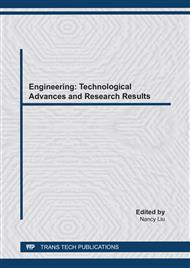[1]
A. D. Aziiz, M. Donny Koerniawan, and Suhendri, Buoyancy-Driven Ventilation Generated by the Double-Skin Façade of a High-Rise Building in Tropical Climate: Case Study Bandung, Indonesia,, MATEC Web Conf., vol. 138, p.01016, (2018).
DOI: 10.1051/matecconf/201713801016
Google Scholar
[2]
A. D. Aziiz, S. Wonorahardjo, and M. Donny Koerniawan, Effectiveness of Double Skin Façade in Controlling Indoor Air Temperature of Tropical Buildings,, Bandung, (2017).
DOI: 10.1088/1755-1315/152/1/012016
Google Scholar
[3]
F. Haldi and D. Robinson, Interactions with window openings by office occupants,, Build. Environ., vol. 44, no. 12, p.2378–2395, (2009).
DOI: 10.1016/j.buildenv.2009.03.025
Google Scholar
[4]
S. A. Damiati, S. A. Zaki, H. B. Rijal, and S. Wonorahardjo, Field study on adaptive thermal comfort in office buildings in Malaysia, Indonesia, Singapore, and Japan during hot and humid season,, Build. Environ., vol. 109, p.208–223, Nov. (2016).
DOI: 10.1016/j.buildenv.2016.09.024
Google Scholar
[5]
T. H. Karyono and G. Bahri, Energy efficient strategies for JSX building in Jakarta , Indonesia,, Int. Conf. Passiv. Low Energy Cool. Built Environ., no. May, p.207–211, (2005).
Google Scholar
[6]
T. Kubota, H. B. Rijal, and H. Takaguchi, Sustainable houses and living in the hot-humid climates of Asia. (2018).
DOI: 10.1007/978-981-10-8465-2
Google Scholar
[7]
Y. He, W. Chen, Z. Wang, and H. Zhang, Review of fan-use rates in field studies and their effects on thermal comfort, energy conservation, and human productivity,, Energy Build., vol. 194, p.140–162, Jul. (2019).
DOI: 10.1016/j.enbuild.2019.04.015
Google Scholar
[8]
F. Mofidi and H. Akbari, Integrated optimization of energy costs and occupants' productivity in commercial buildings,, Energy Build., vol. 129, p.247–260, Oct. (2016).
DOI: 10.1016/j.enbuild.2016.07.059
Google Scholar
[9]
S. Naylor, M. Gillott, and T. Lau, A review of occupant-centric building control strategies to reduce building energy use,, Renew. Sustain. Energy Rev., vol. 96, p.1–10, Nov. (2018).
DOI: 10.1016/j.rser.2018.07.019
Google Scholar
[10]
F. Idealistina, Model termoregulasi tubuh untuk penentuan besaran kesan termal terbaik dalam kaitannya dengan kinerja manusia,, Institut Teknologi Bandung, (1991).
Google Scholar
[11]
R. J. De Dear et al., Progress in thermal comfort research over the last twenty years,, Indoor Air, vol. 23, no. 6, p.442–461, (2013).
DOI: 10.1111/ina.12046
Google Scholar
[12]
V. Soebarto, H. Zhang, and S. Schiavon, A thermal comfort environmental chamber study of older and younger people,, Build. Environ., vol. 155, p.1–14, May (2019).
DOI: 10.1016/j.buildenv.2019.03.032
Google Scholar
[13]
A. Streinu-Cercel, S. Costoiu, and M. Mârza, Models for the indices of thermal comfort.,, J. Med. Life, vol. 1, no. 2, p.148–156, (2008).
Google Scholar
[14]
SNI, Codes for The Design of Ventilation and Air-Conditioning Systems in Buildings SNI-03-6572-2001,, (2001).
Google Scholar
[15]
Tri Harso Karyono, Penelitian Kenyamanan Termis Di Jakarta Sebagai Acuan Suhu Nyaman Manusia Indonesia,, Dimens. (Jurnal Tek. Arsitektur), vol. 29, no. 1, p.24–33, (2001).
Google Scholar
[16]
A. García, F. Olivieri, E. Larrumbide, and P. Ávila, Thermal comfort assessment in naturally ventilated offices located in a cold tropical climate, Bogotá,, Build. Environ., May (2019).
DOI: 10.1016/j.buildenv.2019.05.013
Google Scholar
[17]
K. E. Charles, Fanger's Thermal Comfort and Draught Models Fanger ' s Thermal Comfort and Draught Models IRC Research Report RR-162,, Natl. Res. Counc. Canada, p.29, (2003).
Google Scholar
[18]
F. Mofidi and H. Akbari, Personalized energy costs and productivity optimization in offices,, Energy Build., vol. 143, p.173–190, May (2017).
DOI: 10.1016/j.enbuild.2017.03.018
Google Scholar
[19]
A. Bruce-Konuah, R. V. Jones, and A. Fuertes, Physical environmental and contextual drivers of occupants' manual space heating override behaviour in UK residential buildings,, Energy Build., vol. 183, p.129–138, Jan. (2019).
DOI: 10.1016/j.enbuild.2018.10.043
Google Scholar
[20]
D. Lai, X. Zhou, and Q. Chen, Measurements and predictions of the skin temperature of human subjects on outdoor environment,, Energy Build., vol. 151, p.476–486, Sep. (2017).
DOI: 10.1016/j.enbuild.2017.07.009
Google Scholar
[21]
Y. Zhai et al., Transient human thermophysiological and comfort responses indoors after simulated summer commutes,, Build. Environ., vol. 157, p.257–267, (2019).
DOI: 10.1016/j.buildenv.2019.04.023
Google Scholar
[22]
S.-Y. Kim, H.-S. Choi, and J.-H. Eum, Energy-Independent Architectural Models for Residential Complex Plans through Solar Energy in Daegu Metropolitan City, South Korea,, Sustainability, vol. 10, no. 2, p.482, (2018).
DOI: 10.3390/su10020482
Google Scholar
[23]
H. Zhang, E. Arens, C. Huizenga, and T. Han, Thermal sensation and comfort models for non-uniform and transient environments, part III: Whole-body sensation and comfort,, Build. Environ., vol. 45, no. 2, p.399–410, Feb. (2010).
DOI: 10.1016/j.buildenv.2009.06.020
Google Scholar
[24]
Y. Y. Lee et al., Surrogate human sensor for human skin surface temperature measurement in evaluating the impacts of thermal behaviour at outdoor environment,, Measurement, vol. 118, p.61–72, Mar. (2018).
DOI: 10.1016/j.measurement.2018.01.010
Google Scholar
[25]
M. Luo et al., The dynamics of thermal comfort expectations: The problem, challenge and impication,, Build. Environ., vol. 95, p.322–329, (2016).
Google Scholar
[26]
G. Elert, The Physics Factbook,, 2007. [Online]. Available: https://hypertextbook.com/facts/2001/AbantyFarzana.shtml.
Google Scholar
[27]
A. C. Cosma and R. Simha, Thermal comfort modeling in transient conditions using real-time local body temperature extraction with a thermographic camera,, Build. Environ., vol. 143, p.36–47, Oct. (2018).
DOI: 10.1016/j.buildenv.2018.06.052
Google Scholar
[28]
M. P. M. Kammers, K. Rose, and P. Haggard, Feeling numb: Temperature, but not thermal pain, modulates feeling of body ownership,, Neuropsychologia, vol. 49, no. 5, p.1316–1321, Apr. (2011).
DOI: 10.1016/j.neuropsychologia.2011.02.039
Google Scholar
[29]
L. Wang, Y. Tian, J. Kim, and H. Yin, The key local segments of human body for personalized heating and cooling,, J. Therm. Biol., vol. 81, p.118–127, (2019).
DOI: 10.1016/j.jtherbio.2019.02.013
Google Scholar


